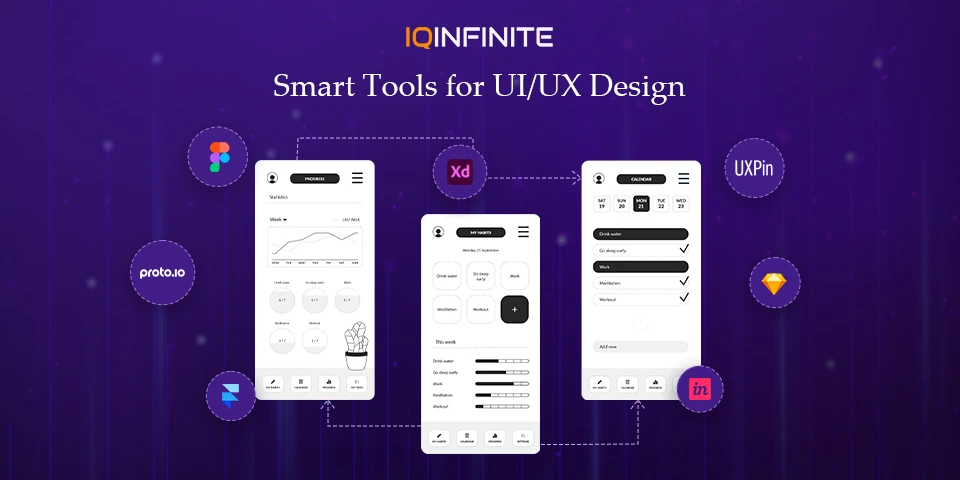Best Prototyping Tools for UI & UX Design

In today’s fast-paced digital world, delivering seamless and engaging user experiences is non-negotiable. Whether you’re designing a mobile app, a responsive website or a digital product, prototyping is an essential step in the UI/UX design process. Prototyping tools not only help you visualize your ideas but also allow you to test interactions, gather feedback and iterate faster.
To help you choose the right tool, here’s a curated list of some of the best prototyping tools for UI & UX design in 2025.
1. Figma
Figma has become the go-to design tool for both beginners and professionals. Its cloud-based nature makes collaboration seamless, allowing teams to design and prototype in real-time.
Key Features:
• Cloud-based with real-time collaboration
• Interactive prototypes with transitions and animations
• Wide plugin ecosystem for extended functionality
• Works across platforms (Windows, macOS and browser)
Best For: Teams looking for collaborative prototyping and design in one tool.
Key Features:
• Cloud-based with real-time collaboration
• Interactive prototypes with transitions and animations
• Wide plugin ecosystem for extended functionality
• Works across platforms (Windows, macOS and browser)
Best For: Teams looking for collaborative prototyping and design in one tool.
2. Framer
Framer has gained huge popularity for its ability to create high-fidelity prototypes with advanced animations and realistic interactions. Unlike static prototypes, Framer makes designs feel like actual products.
Key Features:
• No-code prototyping with realistic animations
• Responsive layout tools for multiple devices
• Direct publishing to share live prototypes
• AI-powered features for faster workflow
Best For: Designers who want to bring concepts to life with micro-interactions and polished UI experiences.
Key Features:
• No-code prototyping with realistic animations
• Responsive layout tools for multiple devices
• Direct publishing to share live prototypes
• AI-powered features for faster workflow
Best For: Designers who want to bring concepts to life with micro-interactions and polished UI experiences.
3. Adobe XD
Adobe XD remains a strong competitor in the design ecosystem, especially for those who are already invested in the Adobe Creative Cloud. It provides a balanced mix of design and prototyping features.
Key Features:
• Seamless integration with Photoshop, Illustrator and other Adobe tools
• Easy drag-and-drop prototyping
• Repeat grid for faster layout creation
• Voice prototyping and 3D transforms
Best For: Designers who are part of the Adobe ecosystem and need a reliable, all-in-one tool.
Key Features:
• Seamless integration with Photoshop, Illustrator and other Adobe tools
• Easy drag-and-drop prototyping
• Repeat grid for faster layout creation
• Voice prototyping and 3D transforms
Best For: Designers who are part of the Adobe ecosystem and need a reliable, all-in-one tool.
4. Sketch
A pioneer in digital design, Sketch continues to be loved by many, especially for macOS users. While it’s not as collaborative out-of-the-box as Figma, its integrations and plugins make it powerful.
Key Features:
• Huge library of plugins and templates
• Vector-based design perfect for UI elements
• Prototyping through integrations with tools like InVision
• Cloud collaboration via Sketch for Teams
Best For: Designers who want a lightweight but powerful Mac-based design tool.
Key Features:
• Huge library of plugins and templates
• Vector-based design perfect for UI elements
• Prototyping through integrations with tools like InVision
• Cloud collaboration via Sketch for Teams
Best For: Designers who want a lightweight but powerful Mac-based design tool.
5. InVision
InVision started as a prototyping tool and has since expanded into a full-fledged design collaboration platform. It’s especially effective for clickable prototypes and stakeholder feedback.
Key Features:
• Intuitive drag-and-drop prototyping
• Interactive hotspots for navigation flow
• Easy feedback collection with comments
• Integrations with Slack, Jira and Trello
Best For: Teams focused on prototyping and feedback rather than full-scale design.
Key Features:
• Intuitive drag-and-drop prototyping
• Interactive hotspots for navigation flow
• Easy feedback collection with comments
• Integrations with Slack, Jira and Trello
Best For: Teams focused on prototyping and feedback rather than full-scale design.
6. UXPin
UXPin stands out because it supports designing with code components, making prototypes look and behave like real products. This is particularly valuable for complex UX workflows.
Key Features:
• Code-based interactive components
• Conditional logic and states
• Accessibility features built-in
• Collaboration with developers
Best For: Designers and developers working on highly interactive or enterprise-level products.
Key Features:
• Code-based interactive components
• Conditional logic and states
• Accessibility features built-in
• Collaboration with developers
Best For: Designers and developers working on highly interactive or enterprise-level products.
7. Proto.io
Proto.io is another tool that emphasizes high-fidelity prototypes without requiring coding knowledge. It allows designers to showcase how the final product will look and function.
Key Features:
• Drag-and-drop interface for easy prototyping
• Extensive UI libraries and templates
• Ability to preview on actual devices
• User testing integrations
Best For: Teams that need to validate ideas quickly with realistic prototypes.
Key Features:
• Drag-and-drop interface for easy prototyping
• Extensive UI libraries and templates
• Ability to preview on actual devices
• User testing integrations
Best For: Teams that need to validate ideas quickly with realistic prototypes.
Conclusion
Prototyping is no longer just an optional step in the design process it’s a necessity. Choosing the right prototyping tool depends on your team’s needs, workflow and the complexity of your projects.
- For collaboration and versatility: Figma or Framer are top choices.
- For high-fidelity, animated prototypes: Framer or UXPin shine.
- For traditional workflows or Adobe users: Adobe XD and Sketch remain reliable.
- For rapid prototyping with feedback: InVision and Proto.io are great options.
By adopting the right prototyping tool, UI/UX designers can accelerate workflows, minimize miscommunication and deliver experiences that truly resonate with users.
